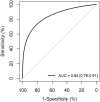Predictive features of chronic kidney disease in atypical haemolytic uremic syndrome
- PMID: 28542627
- PMCID: PMC5436831
- DOI: 10.1371/journal.pone.0177894
Predictive features of chronic kidney disease in atypical haemolytic uremic syndrome
Abstract
Chronic kidney disease (CKD) is a frequent and serious complication of atypical haemolytic uremic syndrome (aHUS). We aimed to develop a simple accurate model to predict the risk of renal dysfunction in aHUS based on clinical and biological features available at hospital admission. Renal function at 1-year follow-up, based on an estimated glomerular filtration rate < 60mL/min/1.73m2 as assessed by the Modification of Diet in Renal Disease equation, was used as an indicator of significant CKD. Prospectively collected data from a cohort of 156 aHUS patients who did not receive eculizumab were used to identify predictors of CKD. Covariates associated with renal impairment were identified by multivariate analysis. The model performance was assessed and a scoring system for clinical practice was constructed from the regression coefficient. Multivariate analyses identified three predictors of CKD: a high serum creatinine level, a high mean arterial pressure and a mildly decreased platelet count. The prognostic model had a good discriminative ability (area under the curve = .84). The scoring system ranged from 0 to 5, with corresponding risks of CKD ranging from 18% to 100%. This model accurately predicts development of 1-year CKD in patients with aHUS using clinical and biological features available on admission. After further validation, this model may assist in clinical decision making.
Conflict of interest statement
Figures
References
-
- Tarr PI, Gordon CA, Chandler WL. Shiga-toxin-producing Escherichia coli and haemolytic uraemic syndrome. Lancet Lond Engl. 2005. March 19;365(9464):1073–86. - PubMed
MeSH terms
LinkOut - more resources
Full Text Sources
Other Literature Sources
Medical



